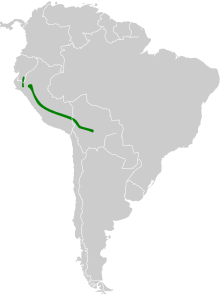Chestnut cap glossy tail
| Chestnut cap glossy tail | ||||||||||||
|---|---|---|---|---|---|---|---|---|---|---|---|---|
|
Chestnut cap glossy tail |
||||||||||||
| Systematics | ||||||||||||
|
||||||||||||
| Scientific name | ||||||||||||
| Chalcostigma ruficeps | ||||||||||||
| ( Gould , 1846) |
The glossy chestnut cap ( Chalcostigma ruficeps ) or sometimes the glossy red cap is a species of bird from the hummingbird family (Trochilidae) that occurs in Ecuador , Peru and Bolivia . The IUCN assesses the population as Least Concern . The species is considered to be monotypical .
features
The shiny chestnut cap reaches a body length of about 10.5 cm, with a weight of 3.3 to 3.9 g. The male has a short straight black beak. The top is bottle green, the underside reddish brown with green speckles especially on the sides. The top of the head is mahogany brown. The narrow throat patch is emerald green and often changes from yellow-green to yellow to golden yellow at the lower edges. The tail is dull olive green. The female has an ocher-orange throat and chest. The sides are mottled olive green and become lighter on the belly. The outer control springs have light-colored tips. Young animals resemble the females.
Behavior and nutrition
The chestnut cap gloss tail draws its nectar u. a. of black- mouthed plants of the genera Miconia and Tibouchina , of Vallea stipularis and of Fuchsia canescens . Occasionally it pricks the base of fuchsias and other plants with long petals in order to get the nectar or uses slits that have already been made by hooked beaks ( Diglossa Wagler , 1832). He seldom fetches the nectar in a whirlwind flight , because it usually clings to the inflorescence. It also feeds on insects. Males defend their forage territory . The foraging takes place in the lower to middle strata .
Reproduction
The breeding season of the glossy chestnut cap in Bolivia is from December to March. Specimens with enlarged gonads were analyzed in August in Bolivia and from July to October in Peru . The clutch consists of two eggs. The hatching is done by the female.
Vocalizations
Little is known about the song of the shiny chestnut cap. The sounds it makes include short, dry rattling trr-trr sounds that it repeats at intervals, and an ascending and descending chirp that sounds like t-tr-tr-tsi-tsii-tititrrr .
distribution and habitat
The glossy chestnut cap prefers moist secondary vegetation, bank thickets and clearings in moist mountain forests as well as moss-covered cloud and cloud forests . Here it moves at altitudes of 1400 to 3500 meters, occasionally even up to 3800 meters. It is most common at altitudes around 2500 meters.
migration
Little research has been done into the migration behavior of the shiny chestnut cap. It is likely to roam the high altitudes as a seasonal line bird . If one accepts the observations made by Karl-Ludwig Schuchmann on Cerro Pan de Azúcar Miraflores in the Valle del Cauca , there could well be wandering movements of the shiny chestnut cap.
Etymology and history of research
The first description of the shiny chestnut cap was in 1846 by John Gould under the scientific name Trochilus (-?) Ruficeps . The type specimen came from Bolivia. In 1854 Heinrich Gottlieb Ludwig Reichenbach introduced the new genus Chalcostigma . This name is derived from the Greek words "chalkos χαλκός " for "bronze, bronze-colored" and "stigma στίγμα " for "feature, marking". The species name ruficeps is a Latin word formation from "rufus" for "red, reddish" and "-ceps, caput, capitis" for "-headed, head".
literature
- Martin Heindl, Peter Boesman in: Josep del Hoyo , Andrew Elliott, Jordi Sargatal , David Andrew Christie , Eduardo de Juana: Rufous-capped Thornbill (Chalcostigma ruficeps) In: Handbook of the Birds of the World Alive . Lynx Edicions, Barcelona.
- James A. Jobling: Helm Dictionary of Scientific Bird Names . Christopher Helm, London 2010, ISBN 978-1-4081-2501-4 .
- John Gould: On twenty new species of Trochilidae or Humming-birds . In: Proceedings of the Zoological Society of London . tape 14 , no. 164 , 1846, pp. 85-90 ( biodiversitylibrary.org ).
- Heinrich Gottlieb Ludwig Reichenbach: Enumeration of the hummingbirds or trochilids in their true natural relationship, including the key to their systematics . In: Journal of Ornithology . 2 (separate issue), 1854, p. 1-24 ( biodiversitylibrary.org ).
- Karl-Ludwig Schuchmann : Notes on the Rufous-capped Thornbill Chalcostigma ruficeps, a new hummingbird species for Colombia . In: Bulletin of the British Ornithologists' Club . tape 98 , no. 4 , 1978, p. 115-116 ( biodiversitylibrary.org ).
- Karl-Ludwig Schuchmann, Martin Heindl: Biography, geographical variation and taxonomy of the Andean hummingbird genus Chalcostigma Reichenbach, 1854 . In: Messages from the Zoological Museum in Berlin . tape 73 , 1997, pp. 131–153 ( researchgate.net [PDF; 2.6 MB ]).
Web links
- Chalcostigma ruficeps inthe IUCN Red List of Threatened Species 2019.1. Listed by: BirdLife International, 2016. Retrieved June 10, 2019.
- BirdLife International: Species Factsheet - Rufous-capped Thornbill ( Chalcostigma ruficeps ) . Retrieved June 10, 2019.
- Videos, photos and sound recordings of Rufous-capped Thornbill (Chalcostigma ruficeps) in the Internet Bird Collection
- Shiny chestnut cap tails ( Chalcostigma ruficeps ) at Avibase; accessed on June 10, 2019.
- Chalcostigma ruficeps in the Integrated Taxonomic Information System (ITIS). Retrieved June 10, 2019.
- xeno-canto: sound recordings - shiny chestnut cap tails ( Chalcostigma ruficeps )
- Rufous-capped Thornbill (Chalcostigma ruficeps) in the Encyclopedia of Life . Retrieved June 10, 2019.
Individual evidence
Remarks
- ↑ Reichenbach categorized, the Schwarzkopf Glanzschwänzchen ( Chalcostigma stanleyi ( Bourcier , 1851)), the bronze-tailed thornbill ( Chalcostigma Heteropogon ( Boissonneau , 1840)), the rainbow-bearded thornbill ( Chalcostigma herrani ( Delattre & Bourcier , 1846)), the chestnut cap Glanzschwänzchen ( Chalcostigma ruficeps ( Gould , 1846)) and Chalcostigma stanleyi vulcani ( Gould , 1852) in the new genus.
